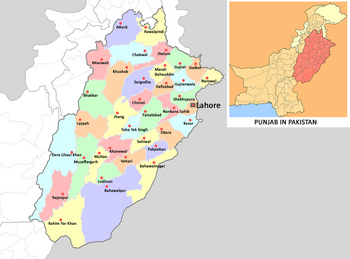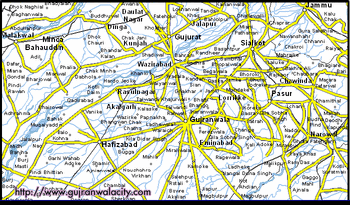Gujranwala


Gujranwala District (Urdu: ضلع گوجرانوالہ) is a district in Punjab province, Pakistan.
Tahsils in the District
Jat clans in Gujranwala District
According to 1911 census, the following were the principal Muslim Jat clans in Gujranwala District [1]:
Aulakh (357), Bajwa (2,483), Bhangu (372), Buttar (842), Chahal (609), Chatha (2,804), Chhina (3,252), Cheema (21,735), Deo (108), Dhariwal (744), Dhillon (769), Dhotar (357), Ghumman (1,429), Gill (2,635), Goraya (3,591), Haral (643), Hanjra (4,334), Kahlon (261), Kharal (12,077), Khokhar (7,893), Lodike (2,675), Maan (463), Mangat (549), Randhawa (577), Sahi (1,050), Sarai (296), Sidhu (196), Sandhu (3,192), Sipra (658), Samra (406), Tarar (4,841), Virk (7,644) and, Waraich (9,510).
History
The village of Asarur which has been identified as the location of Taki, an ancient town, visited by the Chinese pilgrim Hiuen Tsiang contains immense ruins of Buddhist origin. After the time of Tsiang little is known about Gujranwala till the Islamic conquests, by this time however Taki had fallen into oblivion while Lahore had become the chief city of Punjab. The district flourished during Mughal rule, from the days of Akbar to those of Aurangzeb, wells were scattered over the whole country, and villages lay thickly dotted about the southern plateau, now a barren waste of grass land and scrub jungle. Their remains may still be found in the wildest and most solitary reaches of the Bar.
During the rise of Sikh power, the waste plains of Gujranwala were seized by the military adventurers who then sprang up. Charat Singh, the grandfather of Maharaja Ranjit Singh, took possession of the village of Gujranwala, then an inconsiderable hamlet, and made it the headquarters of himself and of his son and grandson. Minor Sikh chieftains settled at Wazirabad Sheikhupura, and other towns; while in the western portion of the District the Bhattis and Chathas maintained a sturdy independence. In the end, however, Ranjit Singh succeeded in bringing all the scattered portions of the District under his own power.
The Maharaja himself was born at Gujranwala, and the town continued to be his capital up to his occupation of Lahore. The mausoleum of his father is still to be seen there, and a lofty cupola close by covers a portion of the ashes of Ranjit Singh himself. The Sikh rule, which brought prosperity elsewhere, also appears to have been an unmitigated benefit to Gujranwala. Ranjit Singh settled large colonies in the various villages, and was very successful in encouraging cultivation throughout the depopulated plain of the Bar. In the Degh valley, especially, he planted a body of hard-working Hindus, the Labanas, to whom he granted the land at a nominal rent.
According to the 1901 census the District had a population of 890,577 and contained 8 towns and 1,331 villages. Its population according to the 1881 census was 616,892 rising to 690,169 in 1891. The population increased by 29 per cent between 1891 and 1901 - the increase being greatest in the Hafizabad and Khangah Dogran tahsils, owing to the extension of canal-irrigation and the colonisation of the Bar.
Maan clan History
Mogalchak (Mughal Chak) is a village of Man Jats in district Gujranwala, Punjab Pakistan.
Mughal Chak was founded by Ladha Maan (लधा मान), who had gone from Lowa Kalan in Jhajjar district of Haryana. [2]
Sir Lepel H. Griffin [3] writes that Ladda Man, the founder of Mogalchak family of Mans migrated from Delhi to country near Gujranwala, founded a village Man and was made it head-man of 22 villages. Nikka Man, the 4th in descent from Ladda Man founded village Nikka, which passed to Mirza Kila, who destroyed it and built a new village and called it Mogalchak.
Notable persons
External links
References
- ↑ Census Of India 1911 Volume xiv Punjab Part 2 by Pandit Narikishan Kaul
- ↑ Jat History Dalip Singh Ahlawat/Chapter III, Page 303
- ↑ The Punjab Chiefs by Sir Lepel H. Griffin (1865)
Back to Pakistan

